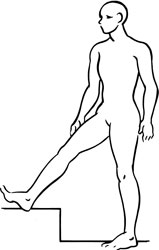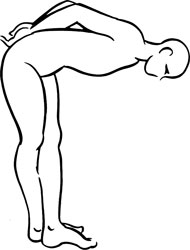Trigger Point Therapy for Myofascial Pain (29 page)
Read Trigger Point Therapy for Myofascial Pain Online
Authors: L.M.T. L.Ac. Donna Finando

Stretch exercise:
Lying supine with the feet on the floor and the knees bent, cross the leg on the unaffected side over the leg on the affected side. Use the upper leg to gently pull the lower leg toward the floor. To ensure that the hip does not rise off the floor or table, the patient may gently apply downward pressure to the anterior superior iliac spine (ASIS) on the affected side with his hand. Hold for a count of fifteen to twenty.
Strengthening exercise:
Positioned on the hands and knees, shift your weight onto one knee, allowing freedom of motion of the working thigh and leg. Keeping the knee of the working leg bent, abduct the leg to bring the inner thigh parallel with the floor. Return the leg to the starting position. Repeat five to ten times.

Stretch exercise: Piriformis

Biceps femoris

Semitendinosus

Semimembranosus
Hamstrings and trigger points
H
AMSTRINGS
B
ICEPS
F
EMORIS
, S
EMITENDINOSUS
, S
EMIMEMBRANOSUS
Proximal attachment:
Biceps femoris, long head:
ischial tuberosity, by a common tendon with semitendinosus.
Biceps femoris, short head:
linea aspera of the femur, along the same portion to which the adductor magnus attaches.
Semitendinosus:
on the ischial tuberosity, by a common tendon with the long head of biceps femoris.
Semimembranosus:
on the ischial tuberosity, lateral and deep to the common tendon of biceps femoris and semitendinosus.
Distal attachment:
Biceps femoris:
both long and short heads attach by a common tendon to the posterior and lateral aspects of the head of the fibula.
Semitendinosus:
medial side of the superior part of the tibia, medial and superficial to semimembranosus, forming the pes anserinus with sartorius and gracilis.
Semimembranosus:
posterior aspect of the medial condyle of the tibia, deep to semitendinosus.
Action:
Biceps femoris, long head:
extension of the thigh.
Biceps femoris, both heads:
flexion of the leg, external rotation of the flexed leg.
Semitendinosus and semimembranosus:
extension of the thigh and flexion of the leg; assists in internal rotation of the leg at the knee.
Palpation:
To locate the hamstrings, identify the following structures:
- Ischial tuberosityâEasily palpable when seated, this bony prominence carries most of the weight of the torso in the seated position. It is located at the center of the buttock, approximately level with the gluteal fold.
- Popliteal fossaâPosterior aspect of the knee joint, which appears as a hollow when the knee is flexed. It is bordered laterally by the tendon of biceps femoris and medially by the tendon of semitendinosus. As you slowly extend the leg you can palpate the fleshy semimembranosus, lying deep to semitendinosus, as it bulges posteriorly and laterally.
Palpate the hamstring group with the patient lying prone. By flexing the leg against resistance the tendons of distal attachment of both the biceps femoris, lying laterally, and the semitendinosus, lying medially, are readily observed.
Palpate biceps femoris through its course, from attachment at the ischial tuberosity to attachment on the head of the fibula. The bulk of semitendinosus fibers lie on the proximal one-half of the medial aspect of the femur, where they can be palpated along their course. Palpate semitendinosus from its attachment at the ischial tuberosity to its attachment on the proximal tibia. The bulk of semimembranosus fibers lie on the distal one-half of the medial aspect of the femur. Semimembranosus fibers can be palpated here, lying deep to semitendinosus, which is less prominent at this portion of the thigh. Semimembranosus remains muscular through to its attachment deep to semitendinosus; its tendon of insertion is not readily palpable.

Biceps femoris

Semitendinosus and Semimembranosus
Hamstrings pain pattern
Pain pattern:
Biceps femoris:
deep aching pain at the posterior and/or lateral knee, possibly extending up the posterior lateral thigh toward the gluteal fold.
Semitendinosus and semimembranosus:
pain in the lower buttock and upper thigh. Pain may extend to the posterior medial thigh and knee, as well as the proximal one-half of the medial calf.
Causative or perpetuating factors:
Compression of the posterior thigh, which may occur while sitting for extended periods of time or in a poorly sized chair.
Satellite trigger points:
Each muscle of the hamstring group may develop satellite trigger points in response to the presence of trigger points in any other muscle of the group. Additional satellite trigger points could also appear in adductor magnus, iliopsoas, quadriceps, quadratus lumborum, paraspinals, and rectus abdominis.
Affected organ system:
Genitourinary system.
Associated zones, meridians, and points:
Dorsal zone; Foot Tai Yang Bladder meridian; BL 36â40.
Semitendinosus and semimembranosus:
also Foot Shao Yin Kidney meridian; KI 10.
Stretch exercises:
The short head of the biceps femoris forms a functional hamstring with adductor magnus. Therapeutic stretching of the hamstring group must therefore coincide with therapeutic stretching of the adductor group in order for each muscle group to obtain full benefit. (See page 183.)
- Place the heel of the leg to be stretched on a step, ledge, or chair. Lean forward slowly, keeping the thigh and hips square. The higher the step, ledge, or chair the greater the stretch on this muscle group. Hold for a count of twenty to thirty, then release.
- In standing, cross the ankles; keep the knees straight and the weight evenly distributed. Bend forward from the hips, maintaining full extension through the knees. Hold for a count of twenty to thirty, then release.
Strengthening exercise:
Lying prone, flex the working leg to a count of two; extend it to return to the prone position to a count of four. The pelvis must remain flat on the floor throughout this exercise. Repeat eight to ten times.
Ankle weights may be used to increase the demand placed on the hamstrings during this exercise. The amount of weight used must be gauged in accordance with the needs and capabilities of the patient.

Stretch exercise 1: Hamstrings

Stretch exercise 2: Hamstrings
